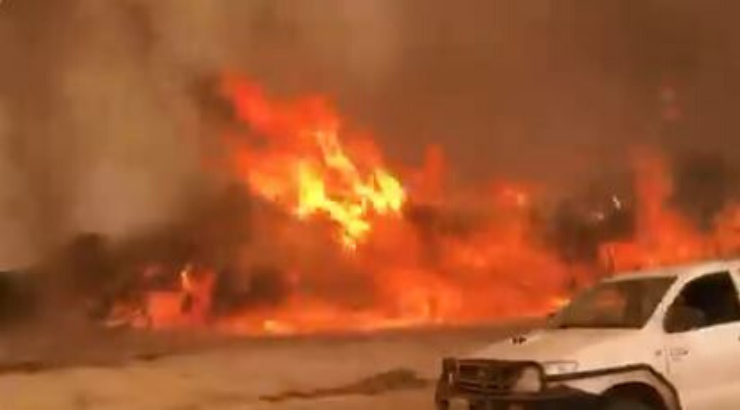 By Elias Marat
By Elias Marat
Australia’s government has announced that it would call up 3,000 military reservists to confront an unprecedented bushfire crisis that is producing nightmarish “firenados”—cyclonic fire-tornadoes—and conditions that some are comparing to the aftermath of nuclear warfare.
On Saturday, beleaguered Prime Minister Scott Morrison sought to reassure the country’s population that his government would take unprecedented measures to contain the fires, which have raged since September. According to AFP, Morrison said:
Today’s decision puts more boots on the ground, puts more planes in the sky, puts more ships at sea.
The addition of 3,000 reservists to firefighting efforts, which have already seen the deployment of roughly 2,000 military personnel, amounts to what authorities say is most likely the largest maritime rescue operation in Australia’s history, reports the New York Times. Military aircraft, naval ships, and other materiel will also be made available to assist evacuation and firefighting efforts.
Defense Minister Linda Reynolds said:
The government has not taken this decision lightly … It is the first time that reserves have been called out in this way in living memory.
The environmental calamity has been stoked by a combination of extreme winds, record-shattering heat waves, and drought-parched forests, grasslands, and brush.
Australia’s bushfires have also grown so monstrous that they are generating their own weather in the form of pyro-cumulonimbus clouds—dry thunderstorms that create more fires—according to Victoria’s Bureau of Meteorology. Fire-generated thunderstorms have appeared over the fires in two different locations. NASA describes them as the “fire-breathing dragon of clouds.”
The #AustralianBushfires are so intense they are creating fire-induced thunderstorms capable of starting new fires through lightning, lofting of embers and generation of powerful wind outflows. Aptly named #pyrocumulonimbus @cnni @CNN @CNNweather @CopernicusEU @BOM_au pic.twitter.com/vIdr89dD84
— Derek Van Dam (@VanDamCNN) January 2, 2020
The storms have further introduced an unpredictable dynamic to the spread of fires and rapid, erratic changes, CNN reports. Bureau of Meteorology spokesman Neil Bennett told Australia’s ABC:
The prediction of fire weather in terms of wind is critical and when you’ve got a highly variable wind environment as you do with a thunderstorm, if you have that in the fire environment, those winds become very, very difficult to predict.
The dry thunderstorms have also triggered cyclonic fire-tornadoes, or “firenados,” which have ripped through arid regions of southern Australia in recent days.
Incredible footage of a so-called “fire twister” on #KangarooIsland has revealed the intensity of the flames burning near the Ravine Des Casoars Wilderness Protection Area. 🌪️
🎥: Kangaroo Island resident Brenton filmed this yesterday. #ausfires #SouthAustralia pic.twitter.com/VngAwBEomL
— ABC Adelaide (@abcadelaide) January 3, 2020
On Monday, firefighter Samuel McPaul was killed in a “truly horrific” incident when extreme weather produced by the fire lifted his 12-ton fire truck into the air and dumped it on its roof. Two other firefighters on the scene are being treated for serious burns due to the “freakish” weather incident.
Shane Fitzsimmons, the New South Wales Rural Fire Service Commissioner, was visibly shaken when he announced how the truck was flipped in what he described as a “pyro-convective line” of “cyclonic type winds.” He said:
The local crews that were able to catch up with him in the field at the accident scene describe what they experienced as truly horrific. They described it as an extraordinary wind event, describing it as a fire tornado.
We have a completely devastated family, a devastated local community at what just has been an extraordinary loss.
As of Saturday, over 23 lives have been claimed by the deadly fires, which have burned over 12 million acres of land, an area larger than Switzerland. On Saturday, Fire Commissioner of the Rural Fire Service in New South Wales (NSW), Shane Fitzsimmons, confirmed to reporters that over 148 active fires continue to burn in his state, 12 of which are at emergency levels. Meanwhile, in Victoria, authorities say that 50 active fires continue to burn.
This was over Blowering pic.twitter.com/gf63vviFSx
— Merrin Macleod (@merxplat) January 4, 2020
Ecologists fear that nearly 500 million mammals, reptiles and birds—including 8,000 koalas—are estimated to have been killed, although the current death toll is impossible to calculate. The massive loss of life threatens to forever tip the balance for entire species of animals and plants on an island continent where 87 percent of wildlife is endemic to the country, meaning it can only be found on Australia.
Kangaroos, koalas, wallabies, wombats, potoroos, bandicoots, echidnas, possums, and other species all have populations that live in regions currently being devastated by the fires—and because the fires have extended to the wetlands, dry eucalyptus forests, and even rainforests, the animals have no place to find refuge.
Jim Radford, a research fellow at La Trobe University in Melbourne, told the Times:
We’ve never seen fires like this, not to this extent, not all at once, and the reservoir of animals that could come and repopulate the areas, they may not be there.
Many experts are using terms to describe the crisis that would have previously been unimaginable. New Zealand Herald reports that Andrew Constance, the transport minister in NSW, told ABC radio:
I’ve got to be honest with you, this isn’t a bushfire, it’s an atomic bomb.
It’s indescribable the hell it’s caused and the devastation it’s caused.
By Elias Marat | Creative Commons | TheMindUnleashed.com
Subscribe to Activist Post for truth, peace, and freedom news. Become an Activist Post Patron for as little as $1 per month at Patreon. Follow us on SoMee, Flote, Minds, Twitter, and Steemit.
Provide, Protect and Profit from what’s coming! Get a free issue of Counter Markets today.

Be the first to comment on "“It’s an Atomic Bomb”: Australia Deploys Military as “Firenados” Wreak Havoc, Fire Crisis Grows"